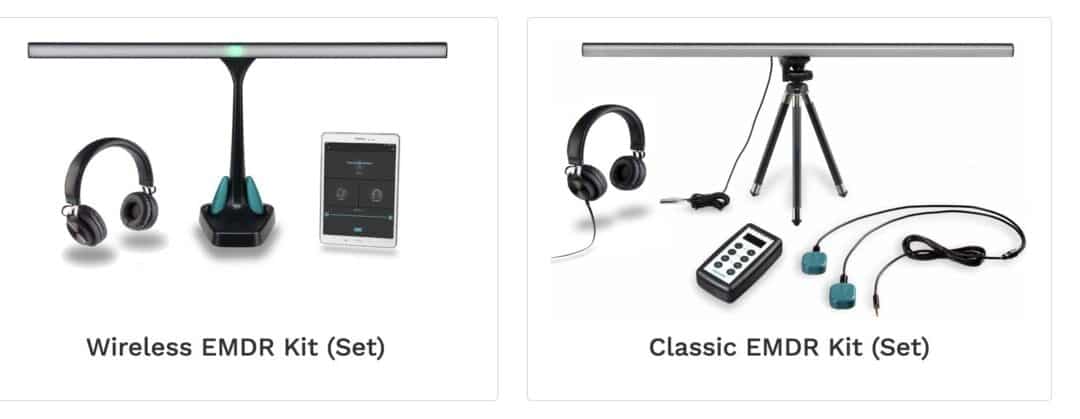EMDR (Eye Movement Desensitization and Reprocessing) is a psychotherapy approach in which the therapist guides their patient’s eye movements as they relive and discuss traumatic memories.
This method of treatment allows the person to talk about their feelings as their focus is drawn to their eye movements. This practice of moving eyes is called bilateral stimulation. However, it’s not the only bilateral stimulation method used.
In addition to visual bilateral stimulation, there is audio and tactile stimulation as well. The latter uses tapping on either side of the body.
Depending on the type of bilateral stimulation, therapists may employ devices for this stage of the therapy. Paddles or buzzers, often known as tappers, are one of these devices.
Tappers are a pair of vibrating gadgets that the customer holds in each hand. The gadget vibrates or buzzes in a right-to-left and left-to-right pattern.
Contents
EMDR and Bilateral Stimulation
Francine Shapiro recognized a link between eye movement and a reduction in the unpleasant emotions connected with her own distressing memories in the late 1980s and created EMDR as a result.
EMDR treatment examines the past, present, and future of clients, with the goal of assisting them in realizing that what occurred to them in the past is not occurring today.
The treatment is generally used by therapists to treat PTSD and trauma reactions. The goal of this therapy is to alter the way traumatic memories are stored in an individual’s brain.
The individual should be able to recall traumatic situations without having the powerful, emotional reactions that define post-traumatic stress after their brain has appropriately processed the memories.
During an EMDR treatment session, the therapist will ask the client to focus on a traumatic memory for a short period of time. They will next tell you to do side-to-side eye motions while recalling the memory. Bilateral stimulation occurs when both sides of your brain are stimulated.
The therapist may utilize rhythmic tapping on both hands or play audio tones aimed toward both ears if the client has visual processing difficulties. Furthermore, individuals may also feel calmer during bilateral brain stimulation.
Desensitization occurs when your brain begins to correlate memory recall with relaxation rather than emotional shock as the memories become less and less vivid.
According to some studies, using eye movements in EMDR can cause physiological changes in the body, such as a slower heart rate, slower breathing, and decreased skin conductance, all of which are signs of calm.
What Tools Are Used in EMDR?
The practice of bilateral stimulation is a principal function of a licensed EMDR therapist in delivering therapy for trauma-related illnesses. It simultaneously activates the left and right sides of the brain, helping the client to form new connections and process painful memories.
EMDR treatment usually consists of an eight-part procedure that takes around 12 weeks to complete. During this period, the therapist would go over the following eight stages:
- Client’s history
- Assessment
- Desensitization
- Installation
- Scan of the entire body
- Closure
- Re-evaluation of treatment
The notion of utilizing devices to induce alternating bilateral stimulations is as old as EMDR, which became a codified therapeutic practice in the 1990s.
During certain contemplative techniques, early practitioners of meditation advised participants to hold bells in both hands and ring them alternately. Most EMDR buzzers, pulsers, and tappers now employ electronics to generate vibrations and track their time.
EMDR tappers are most typically seen in the therapy room, under the supervision of a professional, and are used to assist with a variety of therapies, especially EMDR.
What Are EMDR Tappers?
EMDR treatment works by alternately activating both sides of the brain. It is a research-based therapeutic approach that originally relied on visual stimulation.
Tappers are vibration instruments that use vibration, tapping, or shaking to provide physical sensations on alternating sides of the body.
Bilateral stimulation is one of the EMDR procedures used regularly utilize by therapists with their clients. Using a gadget known as “tappers,” this approach involves producing stimulation on alternating sides of the body via touch.
While many studies into the efficacy of EMDR tappers have been undertaken, the following is an overview of what to expect while using these devices. EMDR tappers all act in the same way and they all provide bilateral stimulation.
Tappers are EMDR devices that employ two vibration devices that the individual holds in their hands or straps on their wrists. These devices provide physical stimuli on a regular basis, with the timing employed to produce stimulation on opposing sides of the body.
The interval between tremors is typically 1.5 to 3 seconds. The gadget vibrates once on the right side and once on the left in a single “pass” of EMDR tappers.
Where To Buy Them?
Various companies sell EMDR tappers. Choosing the best tapper may be confusing for both therapists or those clients self-administering EMDR. Tappers, paddles, buzzers, and pulsators are typical words. All of these terms pertain to the tactile stimulation devices used in EMDR treatment.
EMDR Kit is one of the most dependable manufacturers of EDMR stimulation devices. The firm creates bilateral stimulation devices for a variety of applications. Furthermore, they provide a Wifi-enabled wireless version of these products.
EMDR Kit is available all around the world. They offer two kinds of EMDR Kit Models.
- The EMDR Kit Wireless features a modern design and is totally wireless. It is professional EMDR equipment that costs €433.88.
The charger, headphones, light tube, and pulsators are included in the EMDR Kit Wireless. To use the EMDR Kit Wireless, you will need a smartphone or tablet which means you will not need a controller. - The EMDR Kit Classic comes with a wired controller and is a height-adjustable tripod. It is also portable and features a controller with an inbuilt battery.
The EMDR Kit Classic also includes a light tube, pulsators, headphones, and a controller. It cost €384.30.
Conclusion
EMDR treatment is becoming more widely recognized as an effective therapy across the world. The therapy sessions consist of bilateral stimulation. Depending on the type of bilateral stimulation, therapists may use tappers for this stage of the therapy.
The EMDR Kit incorporates both good design and effective technologies. It comes with a variety of options that therapists can use to customize to their client’s needs.






